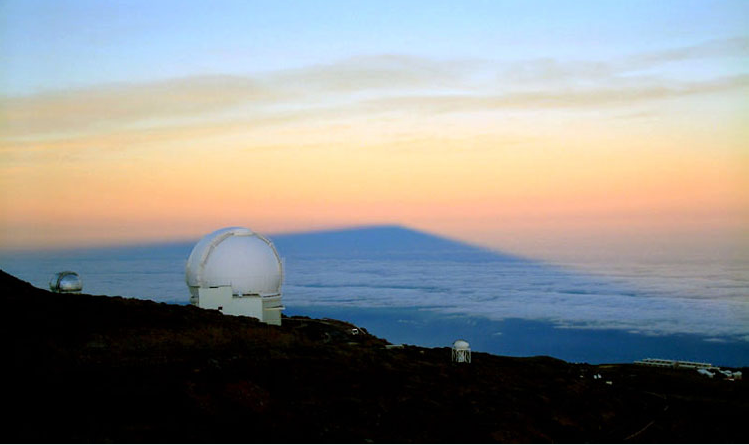Mountain shadow La Palma
The Enigmatic Mountain Shadow of La Palma
Have you ever witnessed a mountain shadow that seems to defy the shape of the mountain itself? La Palma, one of the Canary Islands in Spain, offers a captivating example of this intriguing atmospheric phenomenon. At the summit of Roque de los Muchachos, which stands at an impressive altitude of 2,400 meters, astrophotographer Nik Szymanek captured a sharply triangular shadow. Surprisingly, the mountain's profile does not mirror this triangular shape. This captivating image challenges our understanding of how mountain shadows are formed and opens up a world of questions about the complex interplay between light, terrain, and the atmosphere.
The Mysterious Discrepancy Between Mountain Shape and Shadow
The photograph taken by Szymanek at Roque de los Muchachos Observatory on La Palma perfectly illustrates that mountain shadows do not necessarily mimic the shape of their corresponding mountains. While the shadow takes on a distinct triangular form, the actual mountain profile is irregular and far from triangular. This visual contradiction piques our curiosity and prompts us to explore the underlying physics behind this phenomenon.
The Role of Sunlight in Casting Shadows
To understand why mountain shadows may deviate from the shape of their mountains, we must delve into the behavior of sunlight. When the sun's rays hit a mountain, they are obstructed by its peaks and ridges. As a result, shadows are cast on the opposite side of the mountain. However, the precise shape and characteristics of these shadows are influenced by several factors:
- Sun Angle: The angle at which sunlight hits the mountain affects the length and direction of the shadow.
- Mountain Topography: The irregularities and variations in a mountain's surface can create complex patterns in its shadow.
- Atmospheric Conditions: The presence of atmospheric particles such as dust or water droplets can scatter light, altering the appearance of the shadow.
Exploring the Complex Interplay of Light and Terrain
The phenomenon observed at Roque de los Muchachos highlights the intricate relationship between light and terrain. When sunlight encounters a mountain, it undergoes a series of interactions that shape the resulting shadow. The specific topography of the mountain plays a crucial role in determining the shadow's form. Steep slopes, jagged peaks, and deep valleys can all contribute to the unique characteristics of the shadow.
Atmospheric Optics and the Distorted Shadows
Atmospheric optics studies the behavior of light in the Earth's atmosphere, including the formation of shadows. It offers insights into how various atmospheric conditions can influence the appearance of shadows. In the case of La Palma's mountain shadow, the irregular shape may be attributed to the interplay between light and the atmospheric particles present at that moment. Dust, haze, or even moisture in the air can scatter sunlight, leading to distortions in the shadow's shape.
Capturing the Beauty of Mountain Shadows
Photographers and observers often find themselves captivated by the mesmerizing beauty of mountain shadows. These fleeting moments offer a glimpse into the ever-changing interplay between light and landscape. To capture the essence of these elusive phenomena, photographers employ various techniques:
- Composition: Framing the shot to include both the mountain and its shadow can create a visually striking image.
- Timing: Choosing the right time of day when the sun's angle and position accentuate the shadow can enhance its impact.
- Perspective: Experimenting with different vantage points can reveal unique perspectives on the interplay between light and terrain.
Unraveling the Mysteries of Mountain Shadows
While we have made significant strides in understanding atmospheric optics, there is still much to learn about mountain shadows and their complex formation. Scientists continue to study the intricate interactions between sunlight, terrain, and atmospheric conditions to unravel the mysteries behind these captivating phenomena. Through advanced imaging techniques, computer simulations, and field observations, researchers strive to gain deeper insights into the physics behind the formation of mountain shadows.
Appreciating the Wonders of Nature
La Palma's enigmatic mountain shadow serves as a reminder of the intricate beauty and complexity of the natural world. It reminds us that even in seemingly familiar phenomena, there is always room for discovery and exploration. By marveling at the play of light and shadow on our planet's diverse landscapes, we can deepen our appreciation for the wonders that surround us.
Conclusion
The triangular mountain shadow captured by Nik Szymanek on La Palma's Roque de los Muchachos challenges our expectations and prompts us to delve into the fascinating world of atmospheric optics. Through the interplay of sunlight, terrain, and atmospheric conditions, mountain shadows can deviate from the shape of their mountains, creating visually captivating discrepancies. As we continue to explore and understand these phenomena, we gain a greater appreciation for the intricate beauty and complexity of nature.

Roque de los Muchachos, La Palma, Canary Islands/Spain. Nik Szymanek ( astrophotography site book ) saw this sharply triangular shadow from the 2,400m summit. The mountain profile (right) is irregular and very decidedly non triangular. It neatly demonstrates that mountain shadows do not mimic the shape of their mountain. The peak houses the Roque de los Muchachos Observatory (IAC) . The large dome is that of the 4.2m William Herschel telescope. Large image ©Nik Szymanek - Mountain profile ©Observatorio del Roque de los Muchachos (IAC), both shown with permission.

Note: this article has been automatically converted from the old site and may not appear as intended. You can find the original article here.
Reference Atmospheric Optics
If you use any of the definitions, information, or data presented on Atmospheric Optics, please copy the link or reference below to properly credit us as the reference source. Thank you!
-
<a href="https://atoptics.co.uk/blog/mountain-shadow-la-palma/">Mountain shadow La Palma</a>
-
"Mountain shadow La Palma". Atmospheric Optics. Accessed on November 26, 2024. https://atoptics.co.uk/blog/mountain-shadow-la-palma/.
-
"Mountain shadow La Palma". Atmospheric Optics, https://atoptics.co.uk/blog/mountain-shadow-la-palma/. Accessed 26 November, 2024
-
Mountain shadow La Palma. Atmospheric Optics. Retrieved from https://atoptics.co.uk/blog/mountain-shadow-la-palma/.